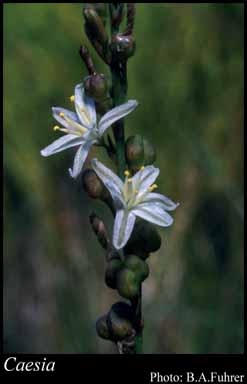- Reference
- Prodr.Fl.Nov.Holland. 277 (1810)
- Name Status
- Current

Scientific Description
Family Anthericaceae.
Sometimes included in Liliaceae.
Habit and leaf form. Herbs (tufted, aerial stem erect, simple or branched); evergreen, or deciduous. Perennial. Leaves basal, or basal and cauline (crowded at the base). Plants with a basal concentration of leaves, or with neither basal nor terminal concentrations of leaves; rhizomatous, or tuberous (may also lack a perennating organ). Self supporting, or climbing. Mesophytic, or xerophytic. Leaves alternate; spiral, or distichous; ‘herbaceous’, or leathery, or membranous; sessile; sheathing. Leaf sheaths not tubular; with free margins. Leaves edgewise to the stem, or with ‘normal’ orientation; simple. Leaf blades entire; flat, or folded, or solid (or triquetrous); linear, or lanceolate, or oblong, or ovate; linear (elongate, grass-like); parallel-veined; without cross-venules; sheathing. Leaves ligulate, or eligulate; without stipules. Leaf blade margins entire. Leaf anatomy. Hairs absent. Extra-floral nectaries absent. Stem anatomy. Secondary thickening absent.
Reproductive type, pollination. Fertile flowers hermaphrodite. Unisexual flowers absent. Plants hermaphrodite. Floral nectaries present. Nectar secretion from the gynoecium (from septal nectaries).
Inflorescence and flower features. Flowers aggregated in ‘inflorescences’; in racemes (simple), or in umbels, or in panicles. The terminal inflorescence unit cymose, or racemose (simple or compound). Inflorescences scapiflorous; terminal; inflorescence axis simple or branched, bracteate; inflorescence annual, many-flowered; flowers distinctly clustered or not clustered or in sessile umbels in the axils of the bracts; with involucral bracts, or without involucral bracts; pseudanthial, or not pseudanthial. Flowers pedicellate (to 15 mm long, articulated at the base); bracteate (on flowering stems, inconspicuous, scarious, lower ones leaf-like, upper ones minute); ebracteolate; small, or medium-sized; regular; 3 merous; cyclic; pentacyclic, or tetracyclic. Perigone tube present. Perianth with distinct calyx and corolla (the whorls rather different), or of ‘tepals’; 6; 2 -whorled (3+3); isomerous; joined; petaloid (more or less); similar in the two whorls, or different in the two whorls; white (rarely), or blue. Calyx (if the outer whorl so interpreted) 3; 1 -whorled; regular. Corolla (if the inner whorl so interpreted) 3; 1 -whorled; regular. Corolla members sometimes fringed, or . Androecial members definite in number. Androecium 6. Androecial members free of the perianth, or adnate (to the perianth); markedly unequal; free of one another; 1 -whorled, or 2 -whorled. Androecium exclusively of fertile stamens, or including staminodes. Staminodes when present, 3. Stamens 6 (in 2 whorls); all more or less similar in shape; isomerous with the perianth, or diplostemonous; on the receptacle at the base of the perianth; alterniperianthial, or oppositiperianthial. Anthers basifixed; versatile; dehiscing via longitudinal slits; introrse; tetrasporangiate. Gynoecium 3 carpelled. The pistil 3 celled. Carpels isomerous with the perianth. Gynoecium syncarpous; synstylovarious, or eu-syncarpous; superior. Ovary plurilocular; 3 locular. Gynoecium stylate. Styles 1; apical (or nearly so). Stigmas 1; 2–3 - lobed; capitate. Placentation axile. Ovules 1–2 per locule; arillate; campylotropous (generally), or anatropous.
Fruit and seed features. Fruit non-fleshy; dehiscent; usually a capsule. Capsules loculicidal (tardily). Fruit 3 celled; 1 seeded (per cell, usually). Seeds endospermic; arillate. Cotyledons 1. Embryo straight to curved.
Additional characters Pollen grains trichotomosulcate.